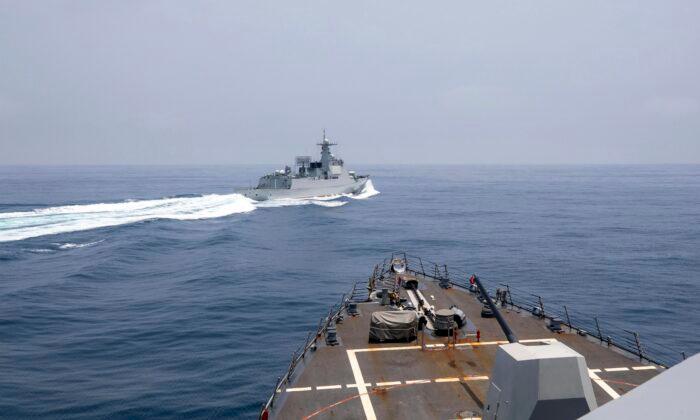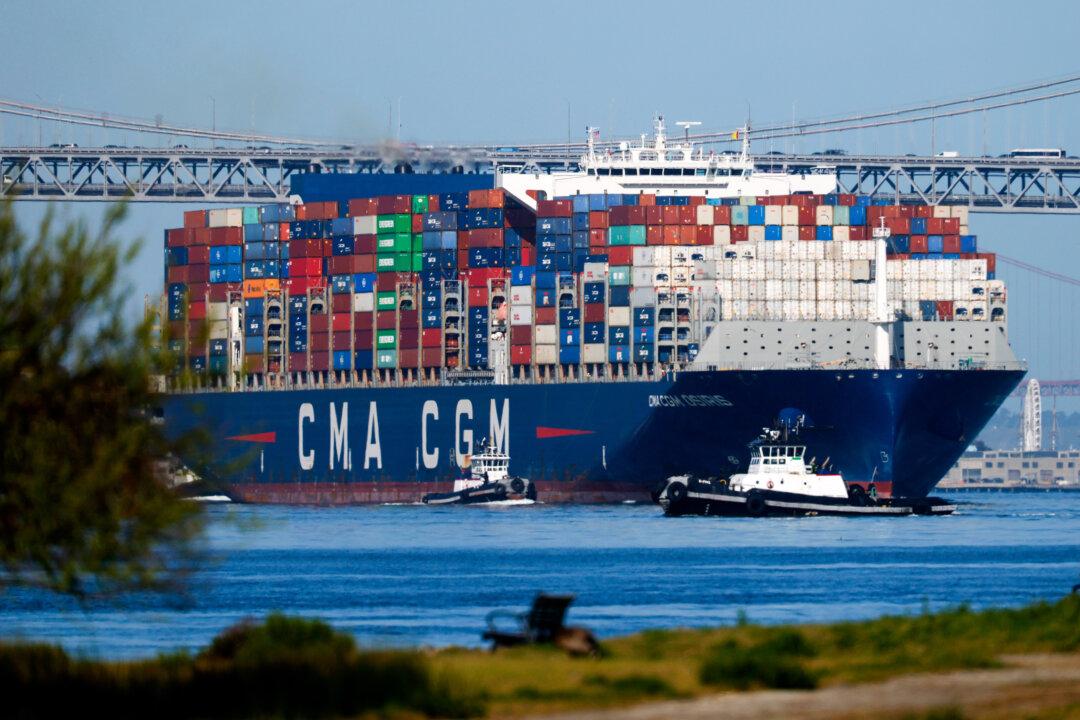China is building a 400-ship navy in what historians say is the swiftest development of sea power since the United States assembled its armada after the Japanese attacked Pearl Harbor during World War II.
But warships are just part of the story.
In addition to fielding the world’s largest navy, the Chinese Communist Party (CCP) has dramatically increased its ship-building capacities, owns or operates more than 90 port operations in 53 nations, has built an 8,000-ship merchant fleet second only to Greece, and has massively invested in oceanographic research, including “deep water stations” on the sea floor.
With the CCP seemingly steaming for a showdown with the U.S. Navy’s 7th Fleet in the Taiwan Straits and South China Sea, ship-building capabilities, port capacities, and oceanographic research are suddenly among the Pentagon’s priorities because, right now, America no longer has the maritime capacity to match China in cargo transport and in laying hulls for new ships.
But maybe it may never need to since threats posed by China’s growing navy is not only an American problem, but a global problem that the world and not the United States by itself, must counter, he said.

US Will Never Regain ‘Maritime Supremacy’
Gilday—accompanied on the panel by ocean carrier CMA CGM America/American President Lines (APL) President Peter Levesque and director of the Scripps Institution of Oceanography Margaret Leinen—said when he joined the Navy in 1985 that the service had 30 industrial private shipyards under contract to build and repair ships.“Now, we’re down to seven,” he said. “And I think in the commercial side, it’s not much different.”
The contraction was a result of many economic influences: Congress refusing to subsidize private shipyards and a post-9/11 emphasis on ground wars, Gilday said.
The United States “lost that” maritime supremacy “about two decades ago,” he said, with the sales of two U.S.-based container shipping companies: APL to interests in Singapore, now based in Japan; and Sealand to Maersk, now based in Germany.
“So today, here we are in the United States with a $23 trillion economy that is very much dependent on our relationships with foreign flag carriers like CMA,” Levesque said. “These big container ships: we don’t build them, we don’t own them, we don’t sail them.”
It’s doubtful U.S.-based shipyards will ever be competitive builders of container or liquefied natural gas (LNG) ships, he said.
“It would be great to bring back U.S. shipbuilding in a big way and be able to build these big container ships in the U.S. But price-wise, it’s almost three times more expensive to build one of these ships in the United States. That’s just the fact,” Levesque said. “It’s purely a cost situation.”
When CMA wants to add to its 600-container ship fleet, the company is “not going to go to the most expensive place to do it. That’s just the way it is,” he said. “It would be great to have it come back. I don’t think it’s possible.”

Allies Key in ‘The Maritime Commons’
But there’s two sides to this coin: the world’s commercial sea carriers rely on the United States’ economy—and the U.S. Navy, Levesque said.“We’re very much dependent on the U.S. economy, that these relationships work. And they do work today, thanks to the Navy and their security, and helping us to have that kind of security in the sea trade lanes,” he said.
Those global relationships in the “Maritime Commons” are the answer to keeping China’s naval growth and “the scale of Chinese dominance of the commercial trade” in check, Levesque said.
South Korea and Japan, for instance, both have extensive shipyards, port capacities, and naval expertise. “Those are the places that we would look at to build new ships, and [manage] the complexity of the ships now, with the LNG and the methane ships that we’re building,” he said.
It’s a similar situation in warship construction, Gilday said, noting that while “we don’t have here today” the shipbuilding capacity to meet the Navy’s needs, the nation’s seven shipyards are the world’s best.
There are “more than 50 ships in construction and another 70-plus under contract” for hull laying in the coming years in the seven shipyards, the Admiral said, and Congress has authorized the U.S. Department of Transportation to offer grants “for some 25 or 27 smaller shipyards to keep them viable in this economy.”
Perhaps more importantly, unlike the PRC, U.S. allies include the world’s best naval architectural firms and shipbuilders, making it “worth examining the market … in terms of in terms of military shipbuilding,” Gilday said.
Italian shipbuilder Fincantieri Marine was awarded $5.5 billion in 2020 to develop the flagship of the Navy’s newest Constellation class of frigates with an option to build nine more in three Wisconsin shipyards.
“So there may be room there for medium-sized shipyards to build those types of ships in the United States in certain areas in the country where perhaps it’s a bit cheaper with respect to the skilled labor—but that’s a challenge in and of itself is having the having the right order the right skill sets and the right numbers,” Gilday said.
And the only way to do that is to keep the skilled labor force building ships and honing skills, which the United States has failed to do over the last four decades, he said.

‘The Ocean of Things’
Gilday said the “growth in the reliance on the ‘Maritime Commons’” makes such cooperative ventures between allies and trading partners more viable than trying to make up for lost time, especially as competition for maritime resources intensifies.“We talk about the ‘Internet of Things’ and now we’re talking about the ‘Ocean of Things,” he said, citing examples that include a “100 increase in offshore wind energy by 2030, and increasing reliance on oil exploration further from shore in deeper waters—that trend is increased.”
And, again, China is vastly out-investing the United States in oceanographic development. But the United States is not alone, Leinen said.
“Although there were lots of players, the U.S. was absolutely dominant in marine science” 20 or so years ago, she said. But it is not China that has disrupted that dominance: it’s been “funding for science by the European Union, in addition to the funding of individual nations.”
“And then there’s China—the growth of marine science in China is staggering,” Leinen said. “In just the last 10 years, we have seen them invest in whole new oceanographic institutions, each of which are as big as Scripps or Woods Hole, constructed out of whole cloth.”
China has established “two new ocean universities” since 2010 and has an oceanographic research vessel “that is larger than any U.S. ocean research vessel,” she said.
Chinese oceanographers are working on a “mega project called ‘deep sea stations,’” Leinen said. “There’s not a lot of information on exactly what China considers a ‘deep sea station’ but you can understand the strategic importance of being able to have a nexus of capabilities in the deep ocean. And so the big challenge for us is not intellectual ability, but the sheer financial tidal wave of funding elsewhere that we’re up against.”
Fortunately, she said, “science is a team sport” and, again, the United States alone does not have to match China dollar-for-dollar in areas where other nations in the “Maritime Commons” also have vital interests and do not want to see dominance by the CCP.

US, Allies Will Never Cede Sea Lanes
The world’s commercial sea-shippers, like CMA, are wary but resolute that they will not cede sea lanes to China’s intimidation, Levesque said.“The major challenge for us is obviously what happens in the South China Sea—$5 trillion of goods flow through the South China Sea every year,” he said. “It’s a major shipping lane, obviously for CMA and for the other carriers.
“We’re worried about what everybody’s worried about—that two planes go bump in the night, or two ships go bump in the night accidentally, and spiral into something bigger. And all of a sudden, we can’t use those trade lanes or insurance companies won’t insure our ships to go through those trade lines. It’s a real concern.”
If the South China Sea becomes “an unusable space,” Levesque said, it would devastate the economies of virtually every nation on Earth, including that of China.
Gilday said the reasons for China’s building such a large navy is uncertain. But if it uses it to disrupt traffic in the South China Sea, whatever point it was trying to make would be lost.
“The lack of transparency concerning their intentions, to how they intend to use their navy, to reach President Xi’s goals are concerning with respect to military expansion,” he said. “That said, I go back to allies and partners, to the increasing reliance on those relationships.
“There’s not a single thing we do out there on the oceans—and we have 100 ships at sea, a third of the fleet out there, any given day—that we’re not doing without allies and partners being involved.”
The best example is how the world’s navies and merchant marines are combating piracy in the Gulf of Aden and off the coast of East Africa, Gilday said.
“The Chinese have been involved in that,” he said. “And they’ve been good partners with respect to combating piracy, supporting [the effort], and keeping those sea lanes open and accessible for all. So that should be a model, I think, for the behavior that we should expect from the PRC, and encourage more of that type of collaborative operations that benefit all of us.”
Gilday said he is “encouraged by the most recent turn in dialogue by senior [Chinese] leaders with respect to toning down what I would say is ‘militaristic tone.’
“I think that’s been helpful,” he said, which is good news because the Chinese navy is going to continue to have plenty of company in the South China Sea with the U.S. 7th Fleet and its allies patrolling the sea lanes, he said, noting the Chinese warship that harassed a U.S. destroyer that was accompanied by a Canadian warship—itself a formidable force.
“We will continue to operate out there and continue to operate forward. We need to assure allies and partners and, at the same time, we need to deter anybody, any nation, that pretends to challenge those international rules; challenges security interests of not only the United States but our allies and partners and put our economic interests in jeopardy,” Gilday said.
“And so I think we will be out there, and we need to be in the way. We can’t just be milling about. It has to be purposeful. And it has to be non-provocative.”





